#psychoanalitic
Text
Your vision will become clear only when you can look into your own heart. Who looks outside, dreams; who looks inside, awakes.
- Carl Jung
#carl jung#carl jung quotes#esoterism#spirituality#astrology#tarotblr#tarot reading#tarot cards#philosophy#esoteric#psyschoanalisis#psychoanalysis#psychoanalitic#philosophy quotes#astrology notes#astrology learning#astro observations#astrologyobservations#paganism#celestial
59 notes
·
View notes
Text
Online Therapy
Need some psychological counseling? Dr. Ricardo A. Rubinstein offers online therapy and psychological counseling services. He is a highly-experienced professional who can help you with a wide range of issues, such as anxiety, depression, relationship problems, and more. Schedule a session now and get started on your road to recovery.

1 note
·
View note
Text
About Loid Forger's therapy in SxF manga chapter 77
(Spoilers ahead)
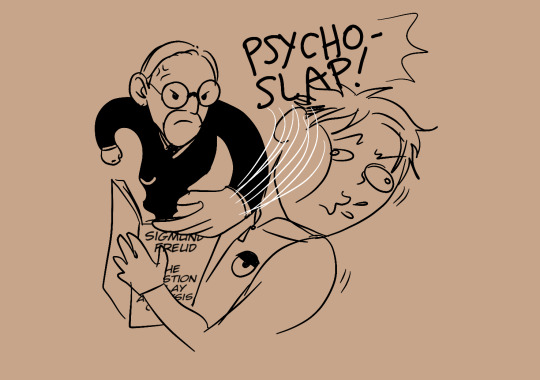
There's a Freudian text for everything. Today's all about The Question of Lay Analysis (1926), also known as Wild Analysis.
Endo did what I have been planning to do for a comic of my own: depict Loid actually working as a Psychiatrist. While I'm glad he took this path, sadly I can't say he did a good job on it.
As some of you know, I'm a therapist grounded in Psychoanalitic Theory. Yes, I like Freud and Lacan, and no, Oedipus Complex is not what you heard it is. I did a brief analysis of Psychiatry stuff in SxF in the past, and today I feel compelled to repeat that exercise.
Let's go in order.
1. The importance of being a third party

What's the reason for which people ask a therapist for help, and not their families or friends? What do we have that they don't?
The answer is pretty simple: neutrality. We don't have a side other than rationality and ethics. A good therapist should be able to listen to his patient without losing objectivity.
When you and your patient have a shared, unique shared experience, it's preferable, even ethical, to refer him to another therapist, in order to preserve the higher interest of the patient. The more neutrality you can muster, the better for the curing process. Otherwise, it's really hard to listen to someone else without being constantly reminded of yourself. It turns into a blind spot.
Now, there are exceptions to this rule, but you must handle them carefully, and always putting the patient at the center. Loid openly talking here about how close he is to the hijacking incident doesn't help much.
In short, you have to ensure that your position in the therapeutic process remains an impartial, neutral Other, and avoid becoming a fellow. It's good to create trust, but not too much, just enough to work.
2. Chronic condition (?)

The biggest difference between a Psychiatrist and a Psychologist is that the first went to Med School. Hence, chronicity is a term that applies mostly for organic conditions, but it's rare in the field of subjectivity.
In my short experience, I've met cases labeled as "chronic depression" being cured. I, myself, cured a case of "compulsive suicide attempts since 15 years old, chronic depression, started hearing evil voices 2 weeks ago". You might think that I'm a great therapist, but it's not the case; it's just that, in order to tackle subjective problems, you ought to go to the root of the symptoms and deal with the subjectivity you find there. Psychoanalitic therapy has proven to be wonderful to treat many conditions that didn't get a cure in other types of psychotherapy.
Of course, it's not a panacea. There are things that we can't figure out yet. But bear in mind that chronicity, in the field of the mind, is more complex than just the passage of time and only a bunch of mental conditions truly admit it.
Jacques Lacan, the most important psychoanalist after Freud, said that the unconscious's track of time is not chronological, but logical. You don't just jump out of adolescence because you turned 18; other things need to happen for you to finally feel like an adult. It's a logical progression. The same can be said about some "chronic" conditions.
3. Explicit Reason of Consultation vs Latent Reason of Consultation
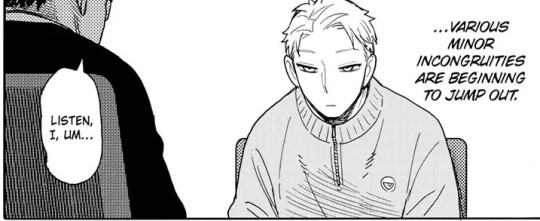
A.K.A Everybody lies.
Psychotherapy is a really weird thing to learn and master. In Psychology School they teach you that you must trust what your patient tells you, but at the same time, distrust him enough. How to conceal both things?
Well, everything is easier when you take Dr. House's words to heart.
Everyone states a reason for consultation, but that first reason is never the real reason, no matter how reasonable it might sound. The trick to discern what the latent, real reason for consultation is, is to determine what the subjective conflict hiding in plain sight is. Sometimes there isn't any and therefore, a full psychotherapy is not necessary (maybe just assisting someone with some things, being there just in case, etc), but most cases are built upon a conflict.
I'm glad that Loid here decided to act like a good Psychiatrist and took a mental note on the oddities.
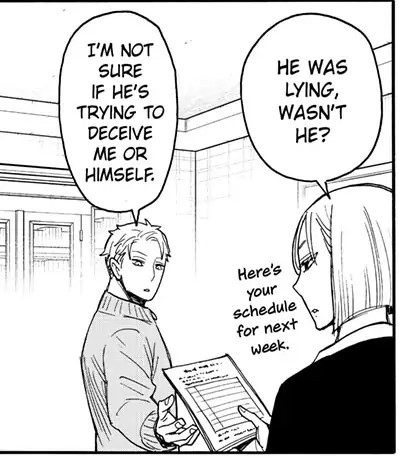
WELL SAID MY BOY, I'M PROUD OF YOU
I want to remark this, because it's discouraging how many therapists oversee this to simplify their job to an extreme. Believe it or not, there are therapists out there that act upon what their patients tell them first. "Hi doc. I came here today because I got an accident and I think I have PTSD". "Ok, I'll have you practice these mindfulness excercises and you should be ok within a month, see ya". DUDE.
4. The place of truth in the context of Psychotherapy

Ah, the classic temptation of knowing the 'real' truth. Is this patient in front of me bullshitting his way out? Is he in a delirium? Is she telling the truth, or just embellishing her story to make it more believable?
You don't have this struggle once you are certain of your role as a psychotherapist. And your role is to help your patients to deal with their subjective struggles.
In short: Psychoterapy deals with the patient's truth, not with the 'real' truth.
You know who deals with 'real' truth in the field of Mental Health? Social Workers.
We psychotherapists don't need to ascertain our patient's claims. Confronting them with reality usually proves to be fruitless, just like Loid did here ("But you're a respected educator!"). It's way more useful to open the topic by asking more questions such as "How did you reach that conclussion?" "What made you think that way?", or giving a specular answer ("You speak like someone else said that about you", "You're too hard with yourself. Where does that come from?", "It sounds like you're belittling your fear for what your wife could say", etc etc etc).
Whenever you're with a neurotic patient, their own personal truth is the only truth you need to work with. Leave the 'real' truth for people who actually needs it, like Social Workers, Doctors or Judges. Your role with a patient is to make sure that his personal truth can turn into something less painful. No need to talk with their friends and family for info, unless your patient is a child or a teenager; just ask him and stick to what he says word by word.
There's a huge topic about the place of reality in therapy, specially in the field of Psychoanalysis, but if I start this train of thought I'm afraid I'll go down to Hell. If you're interested, I've reblogged some Lacanian pills on this Tumblr, check them out by searching the tag #lacan.
PS: NO LOID, DON'T DO THAT. DON'T BREAK THE TRUST YOU ACHIEVED WITH MR AUSTIN! CONFIDENTIALITY IS A MUST!!
5. Counceling = Psychotherapy?

Loid is a (fake) Psychiatrist, not a psychotherapist, so I can't be too hard on him. Also I stan this man. I'm painfully well aware that councelling and coaching is an alternative to psychotherapy in other parts of the world, mostly in the US. But let's not forget one thing:
Psychotherapists DON'T GIVE ADVICES.
At least, not the ones that take this job seriously.
Everyone can give advices. Do you want an advice? Ask your family or friends, or post something in social media, or ask a complete stranger in the street what to do. You'll get plenty of answers and advices. Maybe a bunch of them will be really useful. Good!
The thing with advices is that:
-They act like a universal recipe for a problem
-There's no universal recipe to sort a problem
-They don't tackle the subjective root of a problem
-They assume that the problem can be solved by something you can do upon your surroundings, when the real struggle stems from subjective problems
Some advices do help with real struggles, but when you have a subjective conflict, they barely help; hell, sometimes they make everything worse.
Like Loid here.
Remember when I mentioned that the unconscious mind's track of time is not chronological, but logical? This is a great example. Mr Austin won't be able to properly talk with his wife just because Loid adviced him to; he must solve other issues before that.
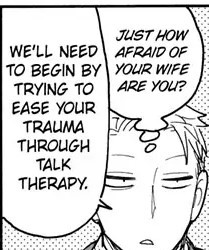
I'm glad we're on the same page on this one
6. Your therapist is not your friend
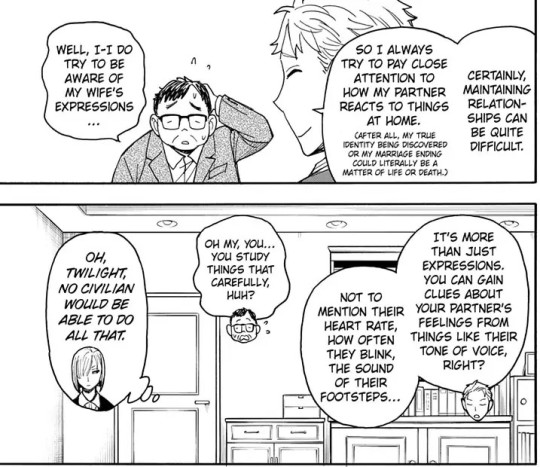
Sad but true.
If your therapist is good enough, you won't know many things about his private life. You won't know about his lover, his hobbies, where does he live, what does he fear.
Why the secretism? Because it's useless for the patient. Also because disclosing personal information has the effect of becoming a model for the patient, who would start to imitate you. And finally, because you need to mantain a semblance of neutrality and not getting emotionally close with the patient more than necessary.
PS: It's kinda cute how aware Loid is about Yor's every movement. Kinda. KISS HER ALREADY, GODDAMNIT
7. Talking cure and (how not to use) the divan

I talked a bit about divans here.
There, I mentioned that you should NEVER PUT A PSYCHOTIC PATIENT IN A DIVAN. NOPENOPENOPENOPENOPENOPE. Well, we can amplify this rule a bit and say that you should avoid the divan with any patient that has a risk of getting seriously upset, like in severe trauma.
The divan is not the only thing that could play against you if badly used. There are cases in Psychiatric Hospitals of patients getting upset because their therapists used the same clothes and hairstyle every single day for months. The point here is that, with psychotic patients and fragile psychic structures (like what happens in traumatized people), you can't use methods that require too much projection.
Also, Lottie here is not performing a Talking Cure.
The divan has been used since Freud to facilitate transference through the Free Association Method. You lay down on it and your therapist ask for whatever crosses your mind first. You don't put a content there beforehand.
(On the same line, if you're a therapist, please refrain from decorating your consultation room with motivational phrases. You're putting words in your patient's mouth before he even starts to speak)
So, it's useless to make Mr Austin lay down on a divan, only to ask him to remember a specific memory. I'd advice (Ha! The irony!) against using the divan here.
----------------------------------------------------------------------------
To finish my Two Cents, I'd like to point some positive aspects of this chapter.
It's nice that a troubled person decides to seek for help. There's still a huge stigma about men requiring mental health help, and it's a nice example to settle to portray one actually going to a Psychiatrist. Men usually struggle with their problems alone and they have it rough.
It's also nice that, in the end, Loid could help his patient. I wonder how (How?!), but it probably means that, at some point of the process, he changed his methods for the better.
And yes. Sometimes, helping one single person can change many lives. I'm honored to be able to attest to that :D
As everyone, I'd expect the logical sucession of events that could follow this chapter: Loid realizing he's got a heck of a wife compared to other marriages, appreciating Yor more, and giving us heavy smut cute TwiYor moments. But Endo has proven to be an author that doesn't like to follow logic. So, let's brace for whatever will come in two weeks.
Thank you for reading!
#spy x family#loid forger#psychiatry#psychoanalysis#sigmund freud#jacques lacan#psychotherapy#spy x family manga#sxf
391 notes
·
View notes
Text
star wars explained for the girlies! *4h of psychoanalitic theory and 2h of mythology studies*
12 notes
·
View notes
Text
Reading that Natalie Portman believes that a female director having a particular gaze is reductive of women's individuality and point of view just shows that even someone as educated as her lacks media literacy and that today's discourse about cinematic gaze is based on very misguided and wrong understandings of the concepts.
If we look at social media, specifically tiktok, we would be lead to believe that a male gaze is what a man likes to look at and the female gaze is the opposite of that, what a woman likes to look at. How did we end up in this place? If we are to talk on such subjects, it would be wise to read upon some seminal works which stand as the basis and starting point of such concepts. We have to go back to John Berger and Laura Mulvey. And after we do that, we can nuance the discussion because there is so much to add to those initial understandings.
The concept of the male gaze has its origins in psychoanalitical theory, particularly scopophilia and Lacan's mirror stage. The man is the bearer of the look and the woman is that which bears the look and in the process she is transformed into an object. Mulvey explained that. All the elements of a film, from director, to DOP to the producing company, are creating this male gaze. But the problem with Mulvey's theory is that she assumed that the audience is strictly heterosexual. How does the concept still stand when a gay man is looking at the objectified woman on screen? Perhaps his gaze is upon the male character? Does that character became an eroticized object or not? How about a lesbian gaze? Is the woman's gaze from the audience the same as the director's?
I don't expect this and more from audiences across platforms, but I just want to point out that there's nothing simplistic there.
As to the concept of female gaze, there is little research, as compared to the male gaze in cinema and media, in order to have a definitive and encompassing theory. What I would say is that it's not the opposite of the male gaze. A female gaze does not automatically objectify men in a heterosexual sense, nor does it translate as objectifying women from a queer perspective.
Yet, it doesn't mean there shouldn't be an apparatus that helps us navigate texts as audiences but also for those who are creating the film and media texts.
Chantal Akerman in Jeanne Dielman did the opposite of the male gaze through filming techniques. She didn't fragment a woman's body and showed it as lacking eroticism. That's a choice that expresses a very clear message. Is it the female gaze? No, it is one of them, but I don't believe it is but one unique female perspective as Portman likes to think and as Akerman said at the time (as a context, Akerman refused the feminist label when the film came out).
There's plenty of women's perspectives in cinemas, but it is time to do the research that would do it justice. It's a lot of work and it must be intersectional because it has to be better and up to date with current understandings of women's identities.
#m thoughts#just some ramblings#I haven't spend much time pondering this and my memory is rusty#I should revisit the texts#but my academic fatigue is still here#so for anyone who knows a lot more than me#or who sees that I wrote smth dumb along the lines#please be understanding
9 notes
·
View notes
Text
ETHEREO-REALISM
February 2020
Declaration of Intention:
The movement declares a new wave of expression.
Neither realism or abstract.
Perpetually seeking it’s purpose, it’s meaning.
What artist has never questioned this rethorical question? What is art?
What's the point of making art? Plato’s theory of Mimesis states that all art is mimetic by nature. Art is imitating life. He believed that “ideas” are the ultimate reality. Art imitates ideas and so it is imitating reality.
Why after all, after the invention of photography and specially now in the digital era , would we continue to reproduce the world as we see it, as we feel it, as we experience it. Just like Sontag and Barthes inquired into the nature and essence of photography, I inquire the need to re purpose photography.
It has been two years since I wrote this essay, the beggining on my manifesto, in which I state that painting,the beaty of drawing and illustration has and will never died. It’s meaningful beaity surpasses it’s utility.
IN FACT.
What we as a society,thought would kill the visual arts,aka the and distribution of photographic cameras in the 1900s, SAW THE RENAISSANCE OF MODERN ART. The avant-garde movements. The ultimate rebellion against capturing reality.
On our continuous search for purpose through artistic expression we question the futility of our actions. To sell or not to sell? That is the question.
Abstract art might upset many classical artists, probably more than to the average person. Abstract art confounds its viewers, how are we supposed to deal with an art completely untethered (inalterada) , from the world of recognizable objects? Why should we? BUT. Freed from the burden of realistic representation it gives space to more interpretation.
Since then,the history of art has been diveded in two opposites,often rivalries.
In my attempt to explore both sides equally, first I must agree on a convienience marriage between the figurative ( the terrenal plane) and the abstract (the astral plane) we intent to explore the three bases of human needs; emotional, spiritual & carnal.
We must shed off the burden of high expectations of traditional mastery,
and become understtanding of the misunderstandment of the abstract.
With the abstraction of realism , the distraction of subject matter is no longer apparent, with it,art can directly act on the soul.
Declaration/ Statement of Intent
We are against the XXI century popular movement of the superficial & fake.
A movement which illustrates the complex imagery of dream or subconscious visions and irrational space and form combinations. Ei. George Grie modern surrealist dreamns, dark gothic, inspirational romanticism etc.
Etherealism explores the conscious, existencialism & expressionism
⦁ Rivalry between classic and modern painting must stinguish
⦁ That each artist must find it own way into abstraction (if they belong to the classics & reject the unkown, the uncertainty of the abstract)
⦁ To explore our subconscious-idealism
⦁ To disfigure reality into our reality
⦁ the introduction of Psychoanalitical realism
⦁ Do not fear the de-construction of matter
⦁ neither the composition of life & perfect beauty
⦁ Meditation through mind and body will lead to your true expression.
⦁ Emotion and consciousness are realities
⦁ Intuition
⦁ Anti mimesis- imitación de la naturaleza como fin esencial del arte
⦁ to use whenever its possible our melancholy & neurasthenia
⦁ the equilibirum of Apollonian & Dyonisioan artistic natures.
⦁ Emotion and consciousness are realities.
⦁ Artistic feeling & Intuition
⦁ Symbolism
⦁ Colour
⦁ Perspective
⦁ Nature
⦁ Space
⦁ Distorsion
Realism
Art is currently in a dormant phase. Stuck either in the past or thrilled by the hope of selling abstract pieces. Society is blinded by the superficiality of fast produced images, suberged in constant self hatred , racism,borders and conflicts. We are afraid of feeling & the reality of life.
Real-ism, real raw artistic expresion. It's absolutley neccesary to get rid of superficiality , superficial beauty, superficial erotism, superficial sensuality, superficial fanatism, superficial instant gratification attention-It's ESSENTIAL to search into the reason and meanings of art making. The lack of purpose comes with the death of art.We are in search of sources and origins of structures of signification.imaginary world's evoking our visual experience.
The pursuit of realistic optical effects, we artists still the attempt to achieve extraordinary realism. But why is this? What is the use of this mimesis and is it worth our time to observe it with awe when the world around us it self is all around us in pure form.since the Romantics vision of artists, artistic endeavour roots from a deep need of expressing a vast variety of emotions ,sometimes beauty,sometimes ugliness.
When "Realism" emerged in the mid 19th century , it was at the same time when photography was emerging and getting the attention into every aspect of our lives.
photography.We can find cameras in technological devices, a large range of photography cameras , digital & analog. Everyone has access to photography.
But the aim of realism was not to glorify mythological or historical figures. BUT to depict the reality around , every day people and places of the time, in no way idealized or sentimentalized. NOT to paint in a photographically realistic manner aka naturalism and this theme has been prelevant throughout human kind history, to depict us humans and our enviroment, our landscapes, the people & their beliefs. It was SHOCKING to paint like life it self, it still is, but it can somehow lack purpose and meaning. It's done for the sake of beeing able to. Sometimes, essential and neccesary skill to become an artist.
The development and use of linear perspective;
helps in crafting the appearance of a three dimensional world on a two dimensional surface.
Shocking immediacy and impact. Looking back to the ancient classics, the greeks, who represent the IDEAL figure. The desire to depict life itself, has long played out in three dimenions. The IMPACT of the wildly uncanny feeling of realism. Realism emerges as a strategry amond many thats combined with other approaches and employed toward a wide variery of ends.
Disrupting many people's expectations about what art should be, showing us the often aggresivly unartful side of every life, and acknowledged the invasiveness of advertising and consumer culture. While the subjects of photorealists paintings aren't usually that remarkable, the skill involved in their reproduction often is.
Cries for help as we drown in an image saturated world or the death rattle of the great pictoral tradition.
ABSTRACT
Throughout the time spam of ( 1780s-2020) artists have demonstrated that things that exist in the world can often look abstract eg. James McNeil, Victor Hugo, William Turner.
Artists became increasingly interested in depicting things non-naturastically, the early stages of abstracting things, ie stylizing,symplifying, flattening it.
Reaching the 20th century artists were painting familiar themes in unfamiliar ways, using intense vivid colours in broad brush strokes that critic dubbed them the Fauvs or Wild Beats. Or as the case of Hilma Af Klint (1862-1944) was painting mostly abstract works as early as 1905 as a form of spiritual communication. The main interest was in the spiritual and the occult, science and the depiction of of invisible forces , recently discovered such as electromagnetic fields.
Annie Besant / Charles Leadbeater had published images in 1901 they called Thought Forms, illustrating their belief that ideas, emotions and sounds manifest as visual auras.
Then the Cubists came along, the Futurists in Italy, German Expressionists such as Ernst Ludwig Kirchner, who used abstraction and rich unreal colours to depict the chaos and anxiety of the streets-city life.
As Kandinsky's interest in to commune with the spiritual, he claimed his art was quote " What the spectator lives or feels while under the effect of the form and colour combinations of the picture". Abstraction was not opposed to Realism. It was realism.
The immediacy & pictorial realities of color and contrast,by Sonia Delaunay & her first disk was considered the first and purest obstraction at the time. As she illustrated an influential book of poetry combining abstraction and typography, a style she extended into painting and fashion.
The sentimentalism of expressionism, this style is filled with emotion, spontaneity, and movement; you can feel an artist’s mood almost jump off of the canvas at times.
It’s all about painting a feeling or experience that is shared with the world through the canvas.
"For this reason we call on all those in the world of science who know that art is a fundamental requirement for our species, that they may direct part of their research towards discovering that malleable substance full of light and instruments that will produce sounds which will enable the development of four dimensional art."- Concrete Art or White Manifesto?
5 notes
·
View notes
Text
Night of a Construction Worker
by Lamberto E. Antonio
The poem talks about a Filipino laborer who experienced difficulties and hardship to his work. They keep staying awoke at night just to have a money to buy their essentials that they need because if not they don't have enough sources that can provide their needs also it is one of the thing to keep them alive. Maybe somebody doesn't mind about their suffering but they still continue to keep thriving as long as they have a goal to achieve in order to survive.
The literary criticism showed is psychoanalitic. It tells how hard being a construction worker that you need to stay awake in the middle of the night to do your job or to have a over time to get an extra money money to buy their needs in their daily lives and it tells the characteristics of a construction worker.
0 notes
Text
CONTEXTO HISTÓRICO
En 1914 estalló la Primera Guerra Mundial y Arthur Klein es llamado a formar filas. Este mismo año Melanie Klein se somete a análisis con Sándor Ferenczi, íntimo amigo de Freud. En 1918 escucha a Freud leer en directo por primera vez con el trabajo Lines of Advance in Psychoanalitic Therapy. Es en el 5º Congreso de Psicoanálisis en la Academia Húngara de Ciencias en Budapest. Un año más tarde, en julio de 1919, presenta el estudio sobre su hijo de cinco años, Erich, a la Sociedad Húngara de Psicoanálisis. Más tarde es premiada con la membresía a esta organización. En 1920 asiste a un Congreso Internacional en La Haya, donde conoce a Joan Rivière.
En 1921, con motivo de la corriente antisemita que empieza a invadir Hungría, Klein se traslada a Berlín. Es a partir de este traslado cuando Melanie empieza su verdadera carrera como psicoanalista infantil; empieza a tratar a niños, asiste a congresos internacionales y se hace miembro de la Sociedad de Psicoanálisis de Berlín. Su amistad con el psicoanalista Ernest Jones la ayudó en este ascenso profesional, sobre todo cuando publica un artículo de Melanie Klein, “The Development of a Child” (“El desarrollo de un niño”) en el International Journal of Psychoanalysis. Este artículo hace que hablen de ella hasta los mismos Karl Abraham y Sigmund Freud.
Durante esta etapa, Melanie Klein se hace amiga de Alix Strachey. Gracias a ella, sus análisis despiertan el interés en la Sociedad Británica. Melanie Klein comienza, entonces a dar una serie de lecturas en Londres con el apoyo de Ernest Jones.
0 notes
Text
Escapism from my own personal death drive?? Did it yesterday, I’ll do it today, and hopefully I’ll do it again tomorrow.
#Freud#death drive#psychoanalitic#philosophy#modernism#I know freud was dumb#but his death drive theory seems pretty dead#philosophically of course#BAD PSYCHOLOGY
4 notes
·
View notes
Text
Major Themes & Assumptions of Psychoanalytic Theory
Firstly, it is important to understand that psychoanalytic theory was not designed as a personality theory per se. Rather, it was the first major, coherent, psychological theory. Psychoanalytic is broad in scope and offered unique, controversial insights into how the human mind worked. In addition, psychoanalytic theory provided a new approach to psychotherapy, thus it provided new treatment techniques for psychological problems that had previously puzzled doctors and others. Unlike other personality theories, the psychoanalytic theory is relatively cohesive (e.g., the Biological Theory consists of many different, separate ideas, models and theories). This approach to personality takes up the challenge of explaining what is going on when what is going on is difficult to understand.
The main thrusts of the psychoanalytic perspective on personality are that:
Psychic energy is needed to make the mind go & the energy (motivation) cannot be destroyed, it must be expressed: The psychoanalytic approach assumes that the psychological apparatus of the mind needs some kind of energy to make it go. This energy is used in psychological work such as planning, thinking, feeling, remembering. The psychic energy is thought to come from 2 main drives: Eros (or libido, the life and sexual instincts) and Thanatos (death instinct). The thinking is that at any time there is only a finite amount of energy available and if it�s busily being used say to repress memories, and deal with anxieties, then it�s not being used fruitfully. If the neuroses can be resolved, then the psychic energy can be freed to use more creatively and productively.
Psychic Determinism: Everything that happens in a person�s mind and everything a person does has a specific, identifiable cause i.e. psychic determinism. Psychoanalysis has no room for miracles, accidents or free will. All seeming contradictions of mind and behaviour can be resolved: nothing is accidental, e.g., it is not accidental when you forget someone�s name, drop something, say one thing and do another. The purpose of psychoanalysis is to dig these hidden causes out, bring them into conscious awareness, and through this insight, the cause can be resolved.
Humans have base instincts (unconscious urges): In Freudian psychology, the unconscious is extremely important in determining behaviour. This is a pervasive theme of the approach: that a lot of desires, motivations and conflicts are seething below the surface, below the level of consciousness. Freud believed that people are driven, fundamentally, by unconscious, animalistic, instinctual urges, particularly lust (eros) and aggression (thanatos). These urges are often in conflict with the demands of society. For example, humans desire pleasure, but society places limits on the kinds of pleasure-seeking which it deems acceptable. Freud emphasizes the extent to which humans are motivated by psychosexual pleasure.
Topography of the psyche (unconscious, pre-conscious, conscious): Using an iceberg metaphor, the unconscious is understood to be the large part of the mind, which is hidden from view. The pre-conscious is represented by the waterline - but it is the zone in which there are fleeting glimpses of the unconscious, "flickering" across the screen of consciousness. Finally, the relatively small part of the iceberg which sticks of the water is seen as equivalent to the small amount of conscious awareness that the human experiences. Freud also believed that if there was information that was too painful for the conscious part to bear, that defense mechanisms would act to push it down it into the unconscious part of the mind.
Structure of Mind (Id, Ego, Superego): The mind has an internal structure -- three parts with separate motivations: Id (irrational and emotional part of the mind); the Ego (rational part); and the Superego (the moral part).
The Way Psychic Conflicts are Resolved Shapes Personality: Personality characteristics are determined by the way in which a person learns to resolve unconscious conflicts amongst the Id, Ego & Superego. This evolves from how people handle several psychosexual stages during childhood. Personality is very strongly influenced by early experiences. Freud was the first to really emphasize the importance of early childhood experiences. People's Id, Ego and Superego develop characteristic patterns of interaction which for them resolve the urges for psychosexual pleasures. However, in some people, a psychosexual stage may not be effectively resolved and this leads to adult personalities characterized being "stuck" at a particular psychosexual stage (e.g., anally retentive or anally expulsive if the 2nd psychosexual stage "anal" (learning how to "let go" of faeces)) is not resolved, depending on which of the Id, Ego, and Superego becomes more dominant. The quality of a person's mental health was seen as determined by the extent to which psychic conflicts had been effectively resolved. If the forces of mind are in balance, according to Freud, then good psychological health ensued. Personality is viewed as a dynamic set of process which are always in motion i.e. psychodynamic. Because of the dynamism, it is possible for an adult personality characteristic to be altered quite dramatically through therapeutic (psychodynamic) insight.
Life is Painful, Therefore We Use Defense Mechanisms to Shield Our Psyche's from the Pain: Psychological defenses are proposed as important aspects of human functioning. Because of human's desire for pleasure (note, they also have destructive instincts), life is essentially too painful for the human being to endure consciously, therefore much of the pain and conflict is diverted via defence mechanisms and kept within the unconscious. It is within the hidden unconscious that much of the conflict takes place, and these conflicts in the unconscious mind are seen as the root of behavior and conscious experience. Apparently paradoxical or irrational behaviors can be accounted for by these inner conflicts, i.e., psychic determinism.*
*Psychic determinism is a type of determinism that theorizes that all mental processes are not spontaneous but are determined by the unconscious or preexisting mental complexes. It relies on the causality principle applied to psychic occurrences in which nothing happens by chance or by accidental arbitrary ways.
Unconscious Leaks Into Conscious Awareness via dreams, slips of the tongue, psychosomatic symptoms, and so on: The unconscious is dynamic, and the psychic energy must go somewhere, plus there is psychic determinism. In other words, whilst the unconscious conflicts may be largely kept from conscious awareness, they still significantly influence behaviors, psychosomatics, plus leak into the preconscious.
Therapeutic Relief Can be Achieved Through Insight into the Unconscious: Therapeutic relief can be effected by helping a person to bring underlying conflicts, often related to past negative learning experiences during critical psychosexual stages. To the extent that insight and understanding can be achieved, and a person can resolve many psychological problems. Note that the therapeutic emphasis on the role and value of achieving "self-insight" is a notion later explored by humanistic psychology. Psychoanalytic therapy was the first "talk therapy" -- it was noticed for the first time formally in psychology that talking about it helps! Psychotherapy may also use project assessment techniques, such as the Rorschach Inkblot Test.
RESOURCE
1 note
·
View note
Text
Piercing Eyes: Feanor, Maeglin, and Other Narratives of Sexual Desire and Fertility in Tolkien’s Gazing,
and other cursed fake essays
#the terrible thing is that I even know how to write this#I've read enough literary analysis with a freudian and psychoanalitical streak#to know EXACTLY how to write this#I will not write it. thank me later#quenta noldorinwa#Feanor#Maeglin
31 notes
·
View notes
Text
About Psychiatry stuff in SPYxFAMILY. Part 1
Part 2 here / Part 3 here / Part 4 here
I'm a dumb and I just realized that ch. 29 of the manga will be animated, since Fiona appears for the 1st time in that chapter and she's in the key visual for the 2nd cour.
I'm aware this isn't the first analysis made on this chapter but so far I haven't seen anyone from the Psy world speaking about this. I'm a Clinical Psychologist grounded on Freudian-Lacanian Psychoanalitic theory and I think I can share some knowledge over several aspects of Psychiatry that are depicted in the manga. I've worked with Psychiatrists in the past, albeit for a short amount of time, in a public healthcare institution, so I have a notion of what Psychiatrists do in a public setting like a Hospital.
If there's a Psychiatrist out there who wants to refute this analysis, PLEASE DO SO. I'm more than pleased to learn and have a nice debate.
This is one of the most hilarious chapters in the whole SxF series, so if you don't want the fun to be spoiled, please skip this post!
Let's begin.
1. Working in a Hospital
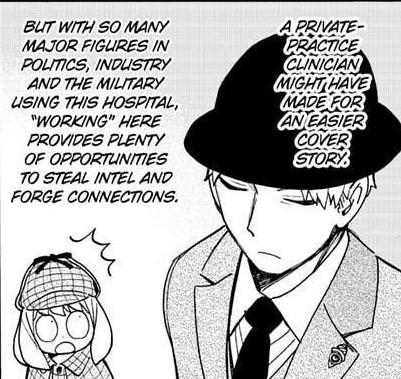
I'm not sure if this is universal, as healthcare systems around the world differ in several aspects, but the consensus is that a Hospital, which is a public healthcare institution, is specialized in the treatment of the most complex diseases.
In Psychiatry, this usually means dealing with psychosis, drug intoxication, major depressive episodes with suicide attempts and serious personality disorders. Most of these conditions require hospitalization, as the risk of giving just ambulatory care is not enough to guarantee the patient's safety or that of the others's.
There are Hospitals that provide ambulatory care though. Again, it varies from where in the world you are. In my country (Chile) you usually go to the Hospital when your life is at risk, but if you are suffering from a less serious condition (for example, dealing with panic attacks), you'll be transferred to a primary healthcare institution. Unless you live in a rural area.
Indeed, working in a healthcare institution means gaining access to any patient's clinical record. But for the objective of Operation Strix, and Loid being a Psychiatrist, I don't think that's of much use, for reasons that I'll cover in Point 3.
2. Specialty in Psychiatry
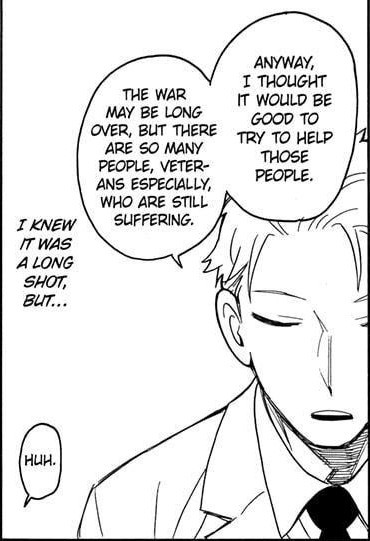
Psychiatry has several subspecialties, like any other healthcare career. You have Child and Adolescent Psychiatry, Adult Psychiatry (I believe these two are mandatory to become a Psychiatrist but I can't say it for sure), Addictions, Forensics, Emergencies...
Loid said that he wants to help people affected by the war, veterans specially, so it's a polite guess to say that he's an Adult Psychiatrist. Then again, we have this panel:
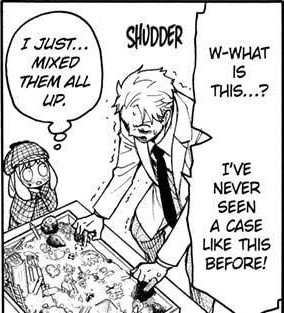
The sand box is a diagnostic tool used for children. It's mostly used by Psychologists, as they have more time per session to analyze it. I'll cover the sand box in more detail in Part 4 of this series of analysis, but for now let's say that analyzing it consumes a lot of time that Psychiatrists, in a Hospital, usually don't have.
This panel suggests that Loid has worked with children before as a Psychiatrist, and we see him later in chapter 67 with a child (although it's not clear if the child is his patient), so here are another 2 polite guesses:
-Loid's a General Psychiatrist
-Berlint General Hospital's Psychiatric Ward is understaffed and they put their Psychiatrists to do whatever is needed at the moment, regardless of their specialties. It sure doesn't look that poor of a Hospital to me, but who knows...
My bet is option 1. Poor guy.
3. Donovan Desmond as a potential psychiatric patient

In the first chapter of the manga, Donovan is described as a hikikomori, meaning someone who withdraws from social interaction. This word also describes a psychopathological condition of japanese young lads that spend months, even years, holled up in their homes without interacting with anybody aside from their families (if they have). The word itself doesn't have a pathological connotation tough.
In English, the closest concept to "hikikomori" as a psychpathological meaning would be Autism, which isn't equivalent at all. And, when a person is so reclused, we tend to pair it with paranoia, as it often leads to social withdrawal as well. The important thing here is, as you probably are thinking right now, the reason fo such decision. And this reason is always given by the symptoms.
Paranoia is a type of psychosis in which a person suffers from delirium and hallucinations related to being endangered or threatened by something. Of course, a proof of reality is useless for these patients, as their perception of reality itself is disturbed. An UFO is watching over you at all times? I can't precisely prove that it's false, as I lack proof of the very existence of UFO, and even if I have it, the delirium would probably shift to attack me as I turn into a conspirator against the patient's truth.
Not that we clinicians waste time trying to do so, though. In these cases, the Psychiatrist kicks in and administers a dose of antipsychotic drugs. Psychotic paranoia often needs hospitalization and a strong compromise from the patient's family to constantly supervise him/her. After that, comes a long process of social rehab.
A very characteristic feat of paranoid people is that THEY NEVER SEEK FOR PROFESSIONAL MENTAL HEALTH CARE HELP BY THEMSELVES. Paranoids often arrive to a Psychiatric Emergency Room dragged by a third party due to bizarre behaviour, self-aggression and/or attempts to hurt others.
There are people that is not psychotic and suffer from this kind of fear of pretty much everything as well, but it's hard to determine if they really aren't psychotics, as their reasons to recluse themselves strongly resemble a delirium. The key that helps to discern if it's a psychotic paranoia or not is finding the hole in which a patient allows himself to doubt. In paranoid psychosis there's absolute certainty, while in neurosis there is room for doubt.
These "neurotic paranoids", as we'll call them for now (it doesn't exist as a nosograhical entity anywhere; please don't waste your time looking it up in the DSM xD), tend to abandon therapy pretty soon, as they fight for sticking with their motives to recluse themselves. They don't want to realize what drive them to behave like that. Patients suffering from obsessions will probably act this way, as well as some hypochondriac and anorexic patients. Bear in mind that this is not a norm; everything depends on the symptoms.
All of this begs the question: Would Donovan Desmond ever need Psychiatric help from Dr. Loid Forger?
His interaction with Loid in chapter 38 suggests that he's not reclusive for a mental condition, but he does have a certain level of "neurotic paranoia", as he can't bring himself to really trust any other person much. If nobody is truly sympathetic to each other, they could pose a threat at any moment, right?
Since he's clearly not psychotic, because he can hold an interaction with Loid in the same shared reality (not a dellirium, I mean), one can safely assume that he does trust someone, at least one single person. When a psychotic person suffers from paranoia, there's not a single hole in their life that is not filled with suspicions of others being dangerous. This isn't the case for Donovan.
We see him walking with a lot of guards, so he must trusts them. And he seems to be closer to Demetrius as he goes with him to the Imperial Scholar get-togethers, so that also counts. He even takes a detour to meet Damian. Seems like he can trust his family members, and that alone could be a measure of love, albeit in a really weird scale.

Tsundere?
That aside, given the social status of the Desmonds, if they ever need psychiatric help, they probably would consult a private clinic instead of going to a public hospital. Unless they find themselves in a reeeeaaaally desperate situation.
So, the answer is no... for the most part. Good try, though, Twilight.
I'll cover more stuff in the next part. This one turned out unexpectedly long. It's been fun ruining the fun for those who don't know about mental health though.
473 notes
·
View notes
Text
i just know someone is gonna send me an ask cause my subconsious went heeheehoohoo mix up etho and cleos names now etho is supposed to marry ren stfu sigmund freud you literally cheated on your wife with her sister kys
5 notes
·
View notes
Text
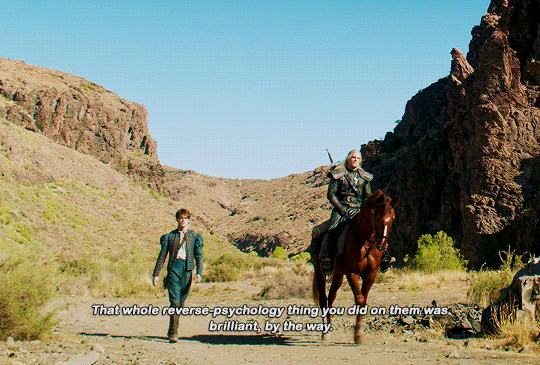
This frame in particular is very important because it proves the existence of Sigmund Freud in the Witcher universe.
#the witcher#witcher au#witcher#where there is psychology there is its father#but like imagine#geralt being psychoanalized by freud#sigmund freud#freud#psychoanalysis#psychology#psychoanalitic theory of the mind#geralion#geralt of rivia#geralt x dandelion#geralt x jaskier#geralskier#geralt imagine
336 notes
·
View notes
Text
actually the more interesting insights based on people's net worth ive read was to separate the top 15% into a 1% and an aspirational 14%. and even then it was more of a psychoanalitic view on the various neuroses of that 14% who are keenly aware they're not in the 1% but wish they were
and even all that was from some weirdo blogger who i dont even think is a leftist
7 notes
·
View notes
Text
I'm doing my intro to psychoanalysis theory assignment and one of the questions is "do you believe in the oedipus complex?" what the hell am i supposed to say? am i supposed to be honest and say "no, in fact i don't" to my psychoanalitic professor just for her to tell me i'm wrong??
#i'm honestly struggling to answer her questionare#i hate that i can't choose my courses#psych student#psychology student#college#university#studyblr
7 notes
·
View notes